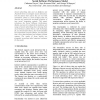Free Online Productivity Tools
i2Speak
i2Symbol
i2OCR
iTex2Img
iWeb2Print
iWeb2Shot
i2Type
iPdf2Split
iPdf2Merge
i2Bopomofo
i2Arabic
i2Style
i2Image
i2PDF
iLatex2Rtf
Sci2ools
HICSS
2008
IEEE
2008
IEEE
Understanding Development and Usage of Social Networking Sites: The Social Software Performance Model
Social networking sites such as MySpace and Facebook thrive on energetic social interaction, but the factors that assure this are not well understood. There is a lack of theory that can describe and predict the successful adoption of new social computing systems. This paper introduces the Social Software Performance Model, and uses it to interpret the evolution and usage of social networking sites. Drawing from socio-technical systems theory, task technology fit, and structuration theory, this model identifies the components of social software, and describes their role in the evaluation and adoption of these systems. The results of three studies are presented, providing initial empirical evidence for the model.
Biometrics | Energetic Social Interaction | HICSS 2008 | Social Networking Sites | Social Software | System Sciences |
| Added | 29 May 2010 |
| Updated | 29 May 2010 |
| Type | Conference |
| Year | 2008 |
| Where | HICSS |
| Authors | Catherine Dwyer, Starr Roxanne Hiltz, George Widmeyer |
Comments (0)

